This course meets the requirements for 3 hours of continuing education credit in jurisdictions which recognize NYS Dept. of Education approval; however participants should be aware that some boards have limitations on the number of hours accepted in certain categories and/or restrictions on certain methods of delivery of continuing education. A certificate will be emailed to you upon successful completion.
Introduction to Radiation Safety
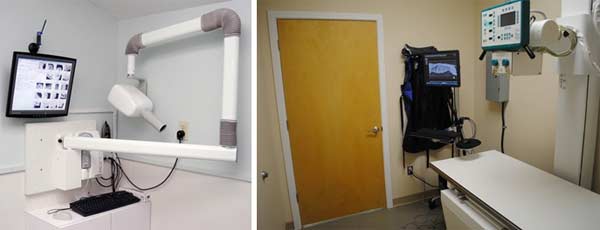
Radiography is an important tool in nondestructive patient evaluation. The method offers a number of advantages over other NDE methods, but one of its disadvantages is the health risk associated with the radiation. Health effects can occur due to either long-term low level exposure or short-term high level exposure.
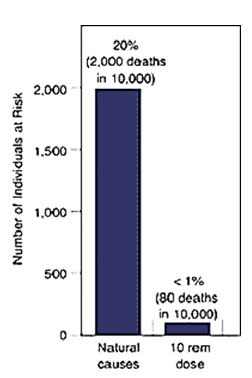 The primary risk from occupational radiation exposure is an increased risk of cancer. The amountGraph of Individuals at Risk of risk depends on the amount of radiation dose received, the time over which the dose is received, and the body parts exposed. Although scientists assume low-level radiation exposure increases one’s risk of cancer, medical studies have not demonstrated adverse health effects in individuals exposed to small chronic radiation doses (i.e., up to 10,000 mrem above background). The increased risk of cancer from occupational radiation exposure is small when compared to the normal cancer rate in today’s society. The current lifetime risk of dying from all types of cancer in the United States is approximately 20 percent (see Figure). If a person received a radiation dose of 10 rem to the entire body (above background), his or her risk of dying from cancer would increase by one percent.
The primary risk from occupational radiation exposure is an increased risk of cancer. The amountGraph of Individuals at Risk of risk depends on the amount of radiation dose received, the time over which the dose is received, and the body parts exposed. Although scientists assume low-level radiation exposure increases one’s risk of cancer, medical studies have not demonstrated adverse health effects in individuals exposed to small chronic radiation doses (i.e., up to 10,000 mrem above background). The increased risk of cancer from occupational radiation exposure is small when compared to the normal cancer rate in today’s society. The current lifetime risk of dying from all types of cancer in the United States is approximately 20 percent (see Figure). If a person received a radiation dose of 10 rem to the entire body (above background), his or her risk of dying from cancer would increase by one percent.
Complicating matters further is the fact that Gamma and X-ray radiation are not detectable by the human body. However, the risks can be minimized when the radiation is handled and managed properly. The law requires that individuals receive training in the safe handling and use of radioactive materials and radiation producing devices. Some of the topics this training should cover include:
- Health concerns associated with exposure to radioactive materials or radiation.
- Precautions or procedures to minimize exposure to radiation.
- Purposes and functions of protective devices employed.
- The permit conditions and the applicable portions of the Radiation Safety Manual.
- Worker’s responsibility to promptly report any condition that may lead to or cause a violation of the regulations or cause an unnecessary exposure.
- Actions to take in the event of an emergency.
- Radiation exposure reports that workers have a right to receive.
This material is intended to provide an overview of the fundamental principles and safety regulations as they apply to radiography. It does not in itself satisfy all of the radiation safety training required by law.
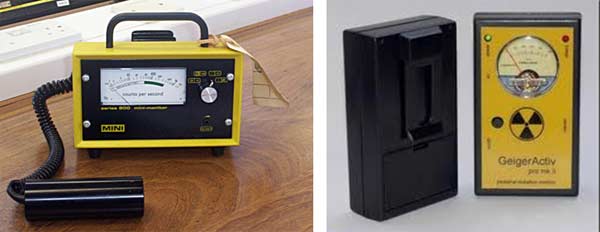
X-Radiation
 Wilhelm Conrad RoentgenX-rays were discovered in 1895 by Wilhelm Conrad Roentgen (1845-1923) who was a Professor at Wuerzburg University in Germany. Working with a cathode-ray tube in his laboratory, Roentgen observed a fluorescent glow of crystals on a table near his tube. The tube that Roentgen was working with consisted of a glass envelope (bulb) with positive and negative electrodes encapsulated in it. The air in the tube was evacuated, and when a high voltage was applied, the tube produced a fluorescent glow. Roentgen shielded the tube with heavy black paper, and discovered a green colored fluorescent light generated by a material located a few feet away from the tube.
Wilhelm Conrad RoentgenX-rays were discovered in 1895 by Wilhelm Conrad Roentgen (1845-1923) who was a Professor at Wuerzburg University in Germany. Working with a cathode-ray tube in his laboratory, Roentgen observed a fluorescent glow of crystals on a table near his tube. The tube that Roentgen was working with consisted of a glass envelope (bulb) with positive and negative electrodes encapsulated in it. The air in the tube was evacuated, and when a high voltage was applied, the tube produced a fluorescent glow. Roentgen shielded the tube with heavy black paper, and discovered a green colored fluorescent light generated by a material located a few feet away from the tube.
Roentgen’s discovery was a scientific bombshell, and was received with extraordinary interest by both scientists and laymen. Experimenters, physicians, laymen, and physicists alike set up X-ray generating apparatus to duplicate his experiments. Public fancy was caught by this invisible ray with the ability to pass through solid matter, and, in conjunction with a photographic plate, provide a picture of bones and interior body parts. Scientific fancy was captured by the demonstration of a wavelength shorter than light. All this work was done with a lack of concern regarding potential dangers. Such a lack of concern is quite understandable, for there was nothing in previous experience to suggest that X-rays would in any way be hazardous. Indeed, the opposite was the case, for who would suspect that a ray similar to light but unseen, unfelt, or otherwise undetectable by the senses would be damaging to a person? More likely, or so it seemed to some, X-rays could be beneficial for the body.
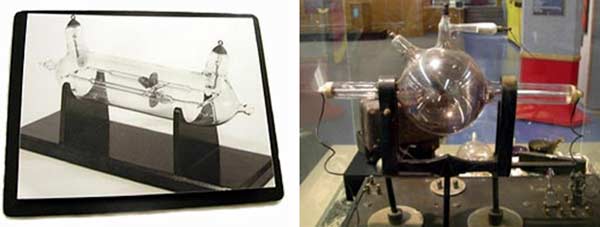
Gamma Radiation
 Shortly after the discovery of x-rays, another form of penetrating rays was discovered. In 1896, French scientist Henri Becquerel discovered natural radioactivity. Many scientists of the period were working with cathode rays, and other scientists were gathering evidence on the theory that the atom could be subdivided. Some of the new research showed that certain types of atoms disintegrate by themselves. Henri Becquerel discovered this phenomenon while investigating the properties of fluorescent minerals. One of the minerals Becquerel worked with was a uranium compound. Uranium ore produces naturally occurring gamma radiation. Becquerel’s discovery was, unlike that of the x-rays, virtually unnoticed by laymen and scientists alike. Only a few scientists were interested in Becquerel’s findings. It was not until the discovery of radium by the Curies two years later that interest in radioactivity became widespread.
Shortly after the discovery of x-rays, another form of penetrating rays was discovered. In 1896, French scientist Henri Becquerel discovered natural radioactivity. Many scientists of the period were working with cathode rays, and other scientists were gathering evidence on the theory that the atom could be subdivided. Some of the new research showed that certain types of atoms disintegrate by themselves. Henri Becquerel discovered this phenomenon while investigating the properties of fluorescent minerals. One of the minerals Becquerel worked with was a uranium compound. Uranium ore produces naturally occurring gamma radiation. Becquerel’s discovery was, unlike that of the x-rays, virtually unnoticed by laymen and scientists alike. Only a few scientists were interested in Becquerel’s findings. It was not until the discovery of radium by the Curies two years later that interest in radioactivity became widespread.
While working in France at the time of Becquerel’s discovery, Polish scientist Marie Curie became very interested in his work. Marie and her husband, French scientist Pierre Curie studied radioactive materials, particularly pitchblende, the ore from which uranium was extracted. They noticed that pitchblende was strangely more radioactive than the uranium extracted from it. They deduced that the pitchblende must contain traces of an unknown radioactive substance far more radioactive than uranium.
Through several years of work, they progressively concentrated the radioactive substances of several tons of pitchblende ore. Their work resulted in the identification of two new chemical elements. The first element, they named “polonium,” after Marie’s native country, Poland. The other element they named “radium,” for its intense radioactivity. Radium became the initial industrial gamma ray source. The material allowed radiographs of castings up to 10 to 12 inches thick to be produced.
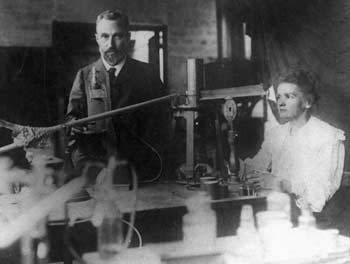
The couple became well known for their work, but they also became victims of radiation poisoning. When early scientists were working with naturally occurring radioactive materials, the effects of radiation on the human body were little understood, or were ignored in the haste to learn more about this new substance. By 1929, industrial radiation sources were becoming available for radiographing extremely thick materials. Exposure times were long, and often radiographers were exposed to excessive doses of radiation.
During World War II and the race to produce a nuclear weapon, much was discovered about radioactive materials, and manmade isotopes became available. These sources were smaller, and considerably stronger than the naturally occurring radioactive material. Manmade sources were developed to penetrate even thicker materials, however, they also cause more damage to persons exposed to the radiation. Many deaths and amputations occurred in this era of early experimentation and use of isotopes.
Health Concerns
The science of radiation protection, or “health physics” as it is more properly called, grew out of the parallel discoveries of x-rays and radioactivity in the closing years of the 19th century. Since early workers with gamma and x-radiation took few, if any, precautions, serious injuries inevitably occurred. Radiation burns were recorded within a month of Roentgen’s announcement of his discovery of x-rays. Becquerel burned himself by carrying a sample of radium in his pocket. Marie and Pierre Curie received radiation burns on their skin from working with radium, and it is suspected their lives were cut short because of exposure to large amounts of radiation. Many developed skin cancer and suffered amputations of fingers and hands as a result of high exposures of radiation. By the 1922, radiation exposure had caused over 150 deaths.
As early as 1900, five years after Roentgen’s discovery, it was understood that precautions needed to be taken when working with x- and gamma radiation. The first warning of possible adverse effects of x-rays came from Thomas Edison, William J. Morton, and Nikola Tesla who each reported eye irritations from experimentation with x-rays and fluorescent substances. Studies of the effects of radiation on living tissue were initiated and the development of safe working practices began. In the 1920’s, the routine use of film badges for personnel monitoring was introduced and the genetic effects of x- and gamma rays were recognized. Adoption of the Roentgen as a unit for measuring radiation by the Second International Congress on Radiation occurred in 1928.
Today, it can be said that radiation ranks among the most thoroughly investigated causes of disease. Although much still remains to be learned, more is known about the mechanisms of radiation damage on the molecular, cellular, and organ system than is known for most other health stressing factors. Moreover, it is the vast accumulation of quantitative dose-response data that enables health physicists to specify radiation levels so that medical, scientific, and industrial uses of radiation may continue at levels of risk comparable with the risks associated with any other technology.
 The image on the right shows severe radiation burns on the back of a man. The man was one of three woodsmen who found a pair of canisters in the mountains of the country of Georgia (formally part of the USSR). The men did not know the canisters were intensely radioactive relics that were once used to power remote generators. Since the canisters gave off heat, the men carried them back to their campsite to warm themselves on a cold winter night.
The image on the right shows severe radiation burns on the back of a man. The man was one of three woodsmen who found a pair of canisters in the mountains of the country of Georgia (formally part of the USSR). The men did not know the canisters were intensely radioactive relics that were once used to power remote generators. Since the canisters gave off heat, the men carried them back to their campsite to warm themselves on a cold winter night.
Nature of Radiation
Radiation is a form of energy. There are two basic types of radiation. One kind is particulate radiation, which involves tiny fast-moving particles that have both energy and mass. Particulate radiation is primarily produced by disintegration of an unstable atom and includes Alpha and Beta particles.
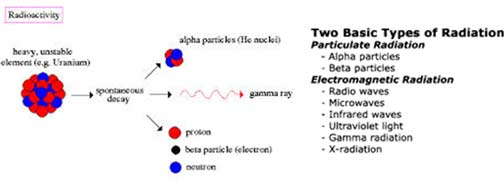
Alpha particles are high energy, large subatomic structures of protons and neutrons. They can travel only a short distance and are stopped by a piece of paper or skin. Beta particles are fast moving electrons. They are a fraction of the size of alpha particles, but can travel farther and are more penetrating.

Particulate radiation is of secondary concern to industrial radiographers. Since these particles have weight and are relatively large, they are easily absorbed by a small amount of shielding. However, it should be noted that shielding materials, such as the depleted uranium used in many gamma radiography cameras, will be a source of Beta particles if the container should ever develop a leak. If a leak were to occur, the material could be transferred to the hands and other parts of a radiographer’s body, causing what is known as particulate contamination. This is the reason periodic “leak” and “wipe tests” are performed on equipment.
The second basic type of radiation is electromagnetic radiation. This kind of radiation is pure energy with no mass and is like vibrating or pulsating waves of electrical and magnetic energy. Electromagnetic waves are produced by a vibrating electric charge and as such, they consist of both an electric and a magnetic component. In addition to acting like waves, electromagnetic radiation acts like a stream of small “packets” of energy called photons. Another way that electromagnetic radiation has been described is in terms of a stream of photons. The massless photon particles each travel in a wave-like pattern. Each photon contains a certain amount (or bundle) of energy, and all electromagnetic radiation consists of these photons. The only difference between the various types of electromagnetic radiation is the amount of energy found in the photons. Electromagnetic radiation travels in a straight line at the speed of light (3 x 108 m/s).
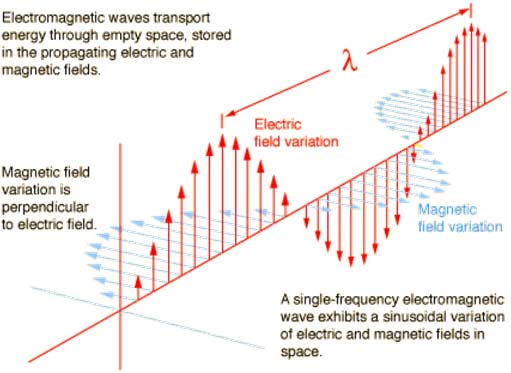
Light waves, radio waves, microwaves, X-rays and Gamma rays are some examples of electromagnetic radiation. These waves differ in their wavelength as shown in the electromagnetic spectrum image above. Although all portions of the electromagnetic spectrum are governed by the same laws, their different wavelengths and different energies allow them to have different effects on matter. Radio waves, for example, have such a long wavelength and low energy that our eyes cannot detect them and they pass through our bodies. It takes a special antenna and electronics to capture and amplify radio waves.
The wavelength of visible light is on the order of 6,000 angstroms, while the wavelength of X-rays is in the range of one angstrom and that of Gamma rays is 0.0001 angstrom. This very short wavelength is what gives X-rays and Gamma rays their power to penetrate materials that light cannot. Unlike light, X- and gamma rays cannot be seen, felt, or heard. The fact that they cannot be detected with our normal human senses and can damage our cells is why they must be treated carefully.
Sources of High Energy Radiation
There are many sources of harmful, high energy radiation. Industrial radiographers are mainly concerned with exposure from x-ray generators and radioactive isotopes, but let’s start by considering sources of radiation in general. It is important to understand that eighty percent of human exposure comes from natural sources such as outer space, rocks and soil, radon gas, and the human body. The remaining twenty percent comes from man-made radiation sources, such as those used in medical and dental diagnostic procedures.
One source of natural radiation is cosmic radiation. The earth and all living things on it are constantly being bombarded by radiation from space. The sun and stars emits EM radiation of all wavelengths. Charged particles from the sun and stars interact with the earth’s atmosphere and magnetic field to produce a shower of radiation, typically beta and gamma radiation. The dose from cosmic radiation varies in different parts of the world due to differences in elevation and the effects of the earth’s magnetic field.
Radioactive material is also found throughout nature. It occurs naturally in soil, water, plants and animals. The major isotopes of concern for terrestrial radiation are uranium and the decay products of uranium, such as thorium, radium, and radon. Low levels of uranium, thorium, and their decay products are found everywhere. Some of these materials are ingested with food and water, while others, such as radon, are inhaled. The dose from terrestrial sources varies in different parts of the world. Locations with higher concentrations of uranium and thorium in their soil have higher dose levels. All people also have radioactive isotopes, such as potassium-40 and carbon-14, inside their bodies. The variation in dose from one person to another is not as great as the variation in dose from cosmic and terrestrial sources.
There are also a number of manmade radiation sources that present some exposure to the public. Some of these sources include tobacco, television sets, smoke detectors, combustible fuels, certain building materials, nuclear fuel for energy production, nuclear weapons, medical and dental X-rays, nuclear medicine, X-ray security systems and industrial radiography. By far, the most significant source of man-made radiation exposure to the average person is from medical procedures, such as diagnostic X-rays, nuclear medicine, and radiation therapy.
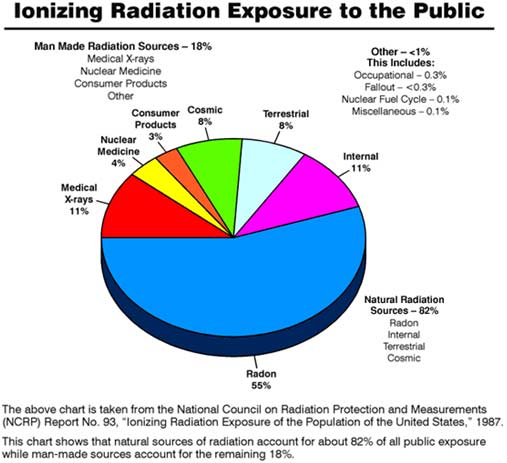
Production of Radiation for Industrial Radiography
Industrial radiography uses two sources of radiation: X-radiation and Gamma radiation. X-rays and Gamma rays differ only in their source of origin. X-rays are produced by an X-ray generator, and Gamma radiation is the product of radioactive atoms. An in depth discussion on radiation production can be found in other areas of this site, but will be reviewed briefly in the following sections.

Production of X-Rays
There are two different atomic processes that can produce X-ray photons. One process produces Bremsstrahlung radiation and the other produces K-shell or characteristic emission. Both processes involve a change in the energy state of electrons. X-rays are generated when an electron is accelerated and then made to rapidly decelerate, usually due to interaction with other atomic particles.
In an X-ray system, a large amount of electric current is passed through a tungsten filament, which heats the filament to several thousand degrees centigrade to create a source of free electrons. A large electrical potential is established between the filament (the cathode) and a target (the anode). The cathode and anode are enclosed in a vacuum tube to prevent the filament from burning up and to prevent arcing between the cathode and anode. The electrical potential between the cathode and the anode pulls electrons from the cathode and accelerates them as they are attracted towards the anode or target, which is usually made of tungsten. X-rays are generated when free electrons give up some of their energy when they interact with the electrons or nucleus of an atom. The interaction of the electrons in the target results in the emission of a continuous Bremsstrahlung spectrum and also characteristic X-rays from the target material.
Production of Gamma Rays
Gamma radiation is the product of radioactive atoms. Depending upon the ratio of neutrons to protons within its nucleus, an isotope of a particular element may be stable or unstable. Over time, the nuclei of unstable isotopes spontaneously disintegrate, or transform, in a process known as radioactive decay. Various types of radiation may be emitted from the nucleus and/or its surrounding electrons when an atom experiences radioactive decay. Nuclides which undergo radioactive decay are called radionuclides. Any material which contains measurable amounts of one or more radionuclides is a radioactive material.
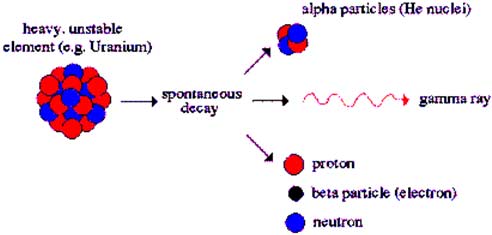
There are many naturally occurring radioactive materials, but manmade radioactive isotopes or radioisotopes are used for industrial radiography. Man-made sources are produced by introducing an extra neutron to atoms of the source material. For example, Cobalt-60 is produced by bombarding a sample of Cobalt-59 with an excess of neutrons in a nuclear reactor. The Cobalt-59 atoms absorb some of the neutrons and increase their atomic weight by one to produce the radioisotope Cobalt-60. This process is known as activation. As a material rids itself of atomic particles to return to a balance state, energy is released in the form of Gamma rays and sometimes alpha or beta particles.
Physical size of isotope materials will very slightly between manufacturer, but generally an isotope is a pellet that measures 1.5 mm x 1.5 mm. Depending on the activity (curies) desired, a pellet or pellets are loaded into a stainless steel capsule and sealed. Unlike X-ray tubes, radioactive sources provide a continual source of radiation that cannot be turned off. Once radioactive decay starts, it continues until all of the atoms have reached a stable state. The radioisotope can only be shielded to prevent exposure to the radiation. In industrial radiography, the instruments that are used to shield the radioisotope so that they can be safely handled and used are commonly called cameras or exposure devices. Exposure devices will be discussed later in more detail.
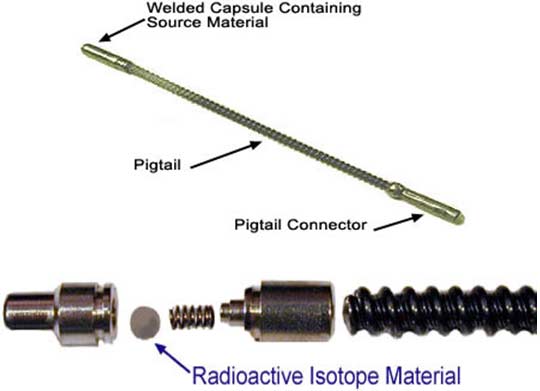
Radioactive Decay and Half-Life
As mentioned previously, radioactive decay is the disintegration of an unstable atom with an accompanying emission of radiation. As a radioisotope atom decays to a more stable atom, it emits radiation only once. To change from an unstable atom to a completely stable atom may require several disintegration steps and radiation will be given off at each step. However, once the atom reaches a stable configuration, no more radiation is given off. For this reason, radioactive sources become weaker with time. As more and more unstable atoms become stable atoms, less radiation is produced and eventually the material will become non-radioactive.
The decay of radioactive elements occurs at a fixed rate. The half-life of a radioisotope is the time required for one half of the amount of unstable material to degrade into a more stable material. For example, a source will have an intensity of 100% when new. At one half-life, its intensity will be cut to 50% of the original intensity. At two half-lives, it will have an intensity of 25% of a new source. After ten half-lives, less than one-thousandth of the original activity will remain. Although the half-life pattern is the same for every radioisotope, the length of a half-life is different. For example, Co-60 has a half-life of about 5 years while Ir-192 has a half-life of about 74 days.

Energy, Activity, Intensity and Exposure
Different radioactive materials and X-ray generators produce radiation at different energy levels and at different rates. It is important to understand the terms used to describe the energy and intensity of the radiation. The four terms used most for this purpose are: energy, activity, intensity and exposure.
Radiation Energy
As mentioned previously, the energy of the radiation is responsible for its ability to penetrate matter. Higher energy radiation can penetrate more and higher density matter than low energy radiation. The energy of ionizing radiation is measured in electronvolts (eV). One electronvolt is an extremely small amount of energy so it is common to use kiloelectronvolts (keV) and megaelectronvolt (MeV). An electronvolt is a measure of energy, which is different from a volt which is a measure of the electrical potential between two positions. Specifically, an electronvolt is the kinetic energy gained by an electron passing through a potential difference of one volt. X-ray generators have a control to adjust the keV or the kV.
The energy of a radioisotope is a characteristic of the atomic structure of the material. Consider, for example, Iridium-192 and Cobalt-60, which are two of the more common industrial Gamma ray sources. These isotopes emit radiation in two or three discreet wavelengths. Cobalt-60 will emit 1.33 and 1.17 MeV Gamma rays, and Iridium-192 will emit 0.31, 0.47, and 0.60 MeV Gamma rays. It can be seen from these values that the energy of radiation coming from Co-60 is about twice the energy of the radiation coming from the Ir-192. From a radiation safety point of view, this difference in energy is important because the Co-60 has more material penetrating power and, therefore, is more dangerous and requires more shielding.

Activity
The strength of a radioactive source is called its activity, which is defined as the rate at which the isotope decays. Specifically, it is the number of atoms that decay and emit radiation in one second. Radioactivity may be thought of as the volume of radiation produced in a given amount of time. It is similar to the current control on a X-ray generator. The International System (SI) unit for activity is the becquerel (Bq), which is that quantity of radioactive material in which one atom transforms per second. The becquerel is a small unit. In practical situations, radioactivity is often quantified in kilobecqerels (kBq) or megabecquerels (MBq). The curie (Ci) is also commonly used as the unit for activity of a particular source material. The curie is a quantity of radioactive material in which 3.7 x 1010 atoms disintegrate per second. This is approximately the amount of radioactivity emitted by one gram (1 g) of Radium 226. One curie equals approximately 37,037 MBq. New sources of cobalt will have an activity of 20 to over 100 curies, and new sources of iridium will have an activity of similar amounts.
Once a radioactive nucleus decays, it is no longer possible for it to emit the same radiation again. Therefore, the activity of radioactive sources decrease with time and the activity of a given amount of radioactive material does not depend upon the mass of material present. Additionally, two one-curie sources of Cs-137 might have very different masses depending upon the relative proportion of non-radioactive atoms present in each source. The concentration of radioactivity, or the relationship between the mass of radioactive material and the activity, is called the specific activity. Specific activity is expressed as the number of curies or becquerels per unit mass or volume. The higher the specific activity of a material, the smaller the physical size of the source is likely to be.
Intensity
Radiation intensity is the amount of energy passing through a given area that is perpendicular to the direction of radiation travel in a given unit of time. The intensity of an X-ray or gamma-ray source can easily be measured with the right detector. Since it is difficult to measure the strength of a radioactive source based on its activity, which is the number of atoms that decay and emit radiation in one second, the strength of a source is often referred to in terms of its intensity. Measuring the intensity of a source is sampling the number of photons emitted from the source in some particular time period, which is directly related to the number of disintegrations in the same time period (the activity).
Exposure
One way to measure the intensity of x-rays or gamma rays is to measure the amount of ionization they cause in air. The amount of ionization in air produced by the radiation is called the exposure. Exposure is expressed in terms of a scientific unit called a roentgen (R or r). The unit roentgen is equal to the amount of radiation that produces in one cubic centimeter of dry air at 0°C and standard atmospheric pressure ionization of either sign equal to one electrostatic unit of charge. Most portable radiation detection safety devices used by a radiographer measure exposure and present the reading in terms of roentgens or roentgens/hour, which is known as the dose rate.
Interaction of Electromagnetic Radiation and Matter
It is well known that all matter is comprised of atoms. But subatomically, matter is made up of mostly empty space. For example, consider the hydrogen atom with its one proton, one neutron, and one electron. The diameter of a single proton has been measured to be about 10-15 meters. The diameter of a single hydrogen atom has been determined to be 10-10 meters, therefore the ratio of the size of a hydrogen atom to the size of the proton is 100,000:1. Consider this in terms of something more easily pictured in your mind. If the nucleus of the atom could be enlarged to the size of a softball (about 10 cm), its electron would be approximately 10 kilometers away. Therefore, when electromagnetic waves pass through a material, they are primarily moving through free space, but may have a chance encounter with the nucleus or an electron of an atom.
Because the encounters of photons with atom particles are by chance, a given photon has a finite probability of passing completely through the medium it is traversing. The probability that a photon will pass completely through a medium depends on numerous factors including the photon’s energy and the medium’s composition and thickness. The more densely packed a medium’s atoms, the more likely the photon will encounter an atomic particle. In other words, the more subatomic particles in a material (higher Z number), the greater the likelihood that interactions will occur Similarly, the more material a photon must cross through, the more likely the chance of an encounter.
When a photon does encounter an atomic particle, it transfers energy to the particle. The energy may be reemitted back the way it came (reflected), scattered in a different direction or transmitted forward into the material. Let us first consider the interaction of visible light. Reflection and transmission of light waves occur because the light waves transfer energy to the electrons of the material and cause them to vibrate. If the material is transparent, then the vibrations of the electrons are passed on to neighboring atoms through the bulk of the material and reemitted on the opposite side of the object. If the material is opaque, then the vibrations of the electrons are not passed from atom to atom through the bulk of the material, but rather the electrons vibrate for short periods of time and then reemit the energy as a reflected light wave. The light may be reemitted from the surface of the material at a different wavelength, thus changing its color.
X-Rays and Gamma Rays
X-rays and gamma rays also transfer their energy to matter though chance encounters with electrons and atomic nuclei. However, X-rays and gamma rays have enough energy to do more than just make the electrons vibrate. When these high energy rays encounter an atom, the result is an ejection of energetic electrons from the atom or the excitation of electrons. The term “excitation” is used to describe an interaction where electrons acquire energy from a passing charged particle but are not removed completely from their atom. Excited electrons may subsequently emit energy in the form of x-rays during the process of returning to a lower energy state.
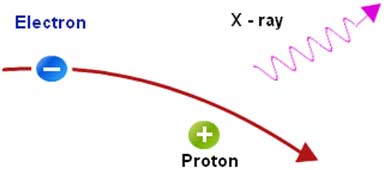
Each of the excited or liberated electrons goes on to transfer its energy to matter through thousands of events involving interactions between charged particles. With each interaction, the energy may be directed in a different direction. The higher the energy of a photon, the more likely the energy will continue traveling in the same direction. As the radiation moves from point to point in matter, it loses its energy through various interactions with the atoms it encounters. If the radiation has enough energy, it may eventually make it through the material.
Photon Interaction with Matter is Key
From the previous paragraph, it can be deduced that the energy of X- and Gamma ray photons is largely responsible for their penetrating power. Einstein linked the energy of a photon to its frequency and wavelength when he postulated that each photon carries an energy of the frequency of the wave times Planck’s constant (E = hƒ). The frequency of an EM wave equals the speed of light divided by the wavelength (ƒ =c/λ ). However, it should be understood that the wavelength or frequency of electromagnetic radiation does not in itself makes the EM wave more or less penetrating. The key is its interaction with matter, or more specifically, whether the photon’s energy is right to excite some transition of a charged particle. For instance, microwaves penetrate glass very easily, but they are strongly absorbed by water. Move up to slightly higher frequency, and infrared is strongly absorbed by both glass and water, but both substances transmit visible light. Ultraviolet is stopped by glass, but not so readily by water.
Ionization and Cell Damage
As previously discussed, photons that interact with atomic particles can transfer their energy to the material and break chemical bonds in materials. This interaction is known as ionization and involves the dislodging of one or more electrons from an atom of a material. This creates electrons, which carry a negative charge, and atoms without electrons, which carry a positive charge. Ionization in industrial materials is usually not a big concern. In most cases, once the radiation ceases the electrons rejoin the atoms and no damage is done. However, ionization can disturb the atomic structure of some materials to a degree where the atoms enter into chemical reactions with each other. This is the reaction that takes place in the silver bromide of radiographic film to produce a latent image when the film is processed. Ionization may cause unwanted changes in some materials, such as semiconductors, so that they are no longer effective for their intended use.
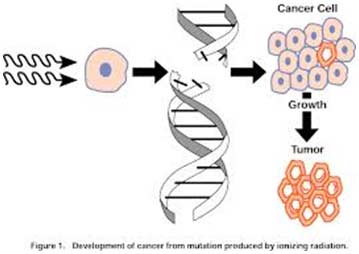
Ionization in Living Tissue (Cell Damage)
In living tissue, similar interactions occur and ionization can be very detrimental to cells. Ionization of living tissue causes molecules in the cells to be broken apart. This interaction can kill the cell or cause them to reproduce abnormally.
Damage to a cell can come from direct action or indirect action of the radiation. Cell damage due to direct action occurs when the radiation interacts directly with a cell’s essential molecules (DNA). The radiation energy may damage cell components such as the cell walls or the deoxyribonucleic acid (DNA). DNA is found in every cell and consists of molecules that determine the function that each cell performs. When radiation interacts with a cell wall or DNA, the cell either dies or becomes a different kind of cell, possibly even a cancerous one.
Cell damage due to indirect action occurs when radiation interacts with the water molecules, which are roughly 80% of a cells composition. The energy absorbed by the water molecule can result in the formation of free radicals. Free radicals are molecules that are highly reactive due to the presence of unpaired electrons, which result when water molecules are split. Free radicals may form compounds, such as hydrogen peroxide, which may initiate harmful chemical reactions within the cells. As a result of these chemical changes, cells may undergo a variety of structural changes which lead to altered function or cell death.
Various possibilities exist for the fate of cells damaged by radiation. Damaged cells can:
- completely and perfectly repair themselves with the body’s inherent repair mechanisms.
- die during their attempt to reproduce. Thus, tissues and organs in which there is substantial cell loss may become functionally impaired. There is a “threshold” dose for each organ and tissue above which functional impairment will manifest as a clinically observable adverse outcome. Exceeding the threshold dose increases the level of harm. Such outcomes are called deterministic effects and occur at high doses.
- repair themselves imperfectly and replicate this imperfect structure. These cells, with the progression of time, may be transformed by external agents (e.g., chemicals, diet, radiation exposure, lifestyle habits, etc.). After a latency period of years, they may develop into leukemia or a solid tumor (cancer). Such latent effects are called stochastic (or random).
Exposure of Living Tissue to Non-ionizing Radiation
A quick note of caution about non-ionizing radiation is probably also appropriate here. Non-ionizing radiation behaves exactly like ionizing radiation, but differs in that it has a much greater wavelength and, therefore, less energy. Although this non-ionizing radiation does not have the energy to create ion pairs, some of these waves can cause personal injury. Anyone who has received a sunburn knows that ultraviolet light can damage skin cells. Non-ionizing radiation sources include lasers, high-intensity sources of ultraviolet light, microwave transmitters and other devices that produce high intensity radio-frequency radiation.
Cell Radiosensitivity
Radiosensitivity is the relative susceptibility of cells, tissues, organs, organisms, or other substances to the injurious action of radiation. In general, it has been found that cell radiosensitivity is directly proportional to the rate of cell division and inversely proportional to the degree of cell differentiation. In short, this means that actively dividing cells or those not fully mature are most at risk from radiation. The most radio-sensitive cells are those which:
- have a high division rate
- have a high metabolic rate
- are of a non-specialized type
- are well nourished
Examples of various tissues and their relative radiosensitivities are listed below.
| High Radiosensitivity |
| Lymphoid organs, bone marrow, blood, testes, ovaries, intestines |
| Fairly High Radiosensitivity |
| Skin and other organs with epithelial cell lining (cornea, oral cavity, esophagus, rectum, bladder, vagina, uterine cervix, ureters) |
| Moderate Radiosensitivity |
| Optic lens, stomach, growing cartilage, fine vasculature, growing bone |
| Fairly Low Radiosensitivity |
| Mature cartilage or bones, salivary glands, respiratory organs, kidneys, liver, pancreas, thyroid, adrenal and pituitary glands |
| Low Radiosensitivity |
| Muscle, brain, spinal cord |
Reference: Rubin, P. and Casarett. G. W.: Clinical Radiation Pathology (Philadelphia: W. B. Saunders. 1968).
Measures Relative to the Biological Effect of Radiation Exposure
There are four measures of radiation that radiographers will commonly encounter when addressing the biological effects of working with X-rays or Gamma rays. These measures are: Exposure, Dose, Dose Equivalent, and Dose Rate A short summary of these measures and their units will be followed by more in depth information below.
- Exposure: Exposure is a measure of the strength of a radiation field at some point in air. This is the measure made by a survey meter. The most commonly used unit of exposure is the roentgen (R).
- Dose or Absorbed Dose: Absorbed dose is the amount of energy that ionizing radiation imparts to a given mass of matter. In other words, the dose is the amount of radiation absorbed by and object. The SI unit for absorbed dose is the gray (Gy), but the “rad” (Radiation Absorbed Dose) is commonly used. 1 rad is equivalent to 0.01 Gy. Different materials that receive the same exposure may not absorb the same amount of radiation. In human tissue, one Roentgen of gamma radiation exposure results in about one rad of absorbed dose.
- Dose Equivalent: The dose equivalent relates the absorbed dose to the biological effect of that dose. The absorbed dose of specific types of radiation is multiplied by a “quality factor” to arrive at the dose equivalent. The SI unit is the sievert (SV), but the rem is commonly used. Rem is an acronym for “roentgen equivalent in man.” One rem is equivalent to 0.01 SV. When exposed to X- or Gamma radiation, the quality factor is 1.
- Dose Rate: The dose rate is a measure of how fast a radiation dose is being received. Dose rate is usually presented in terms of R/hour, mR/hour, rem/hour, mrem/hour, etc.
For the types of radiation used in industrial radiography, one roentgen equals one rad and since the quality factor for x- and gamma rays is one, radiographers can consider the Roentgen, rad, and rem to be equal in value.
More Information on Exposure, Dose, Dose Equivalent, and Dose Rate
Exposure
Exposure is a measure of the strength of a radiation field at some point. It is a measure of the ionization of the molecules in a mass of air. It is usually defined as the amount of charge (i.e. the sum of all ions of the same sign) produced in a unit mass of air when the interacting photons are completely absorbed in that mass. The most commonly used unit of exposure is the Roentgen (R). Specifically, a Roentgen is the amount of photon energy required to produce 1.610 x 1012 ion pairs in one gram of dry air at 0°C. A radiation field of one Roentgen will deposit 2.58 x 10-4coulombs of charge in one kilogram of dry air. The main advantage of this unit is that it is easy to directly measure with a survey meter. The main limitation is that it is only valid for deposition in air.
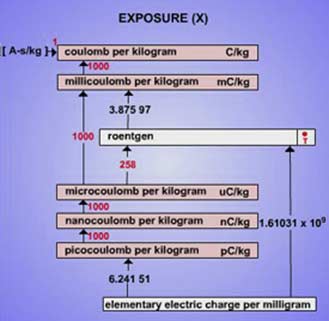
Dose or Absorbed Dose
Whereas exposure is defined for air, the absorbed dose is the amount of energy that ionizing radiation imparts to a given mass of matter. The absorbed dose is used to relate the amount of ionization that x-rays or gamma rays cause in air to the level of biological damage that would be caused in living tissue placed in the radiation field. The most commonly used unit for absorbed dose is the “rad” (Radiation Absorbed Dose). A rad is defined as a dose of 100 ergs of energy per gram of the given material. The SI unit for absorbed dose is the gray (Gy), which is defined as a dose of one joule per kilogram. Since one joule equals 107 ergs, and since one kilogram equals 1000 grams, 1 Gray equals 100 rads.
The size of the absorbed dose is dependent upon the the intensity (or activity) of the radiation source, the distance from the source to the irradiated material, and the time over which the material is irradiated. The activity of the source will determine the dose rate which can be expressed in rad/hr, mr/hr, mGy/sec, etc.
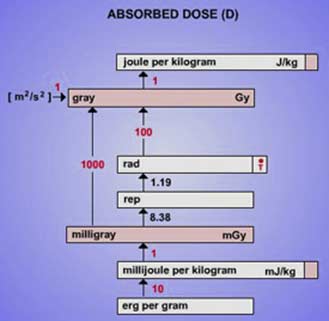
Dose Equivalent
When considering radiation interacting with living tissue, it is important to also consider the type of radiation. Although the biological effects of radiation are dependent upon the absorbed dose, some types of radiation produce greater effects than others for the same amount of energy imparted. For example, for equal absorbed doses, alpha particles may be 20 times as damaging as beta particles. In order to account for these variations when describing human health risks from radiation exposure, the quantity called “dose equivalent” is used. This is the absorbed dose multiplied by certain “quality” or “adjustment” factors indicative of the relative biological-damage potential of the particular type of radiation.
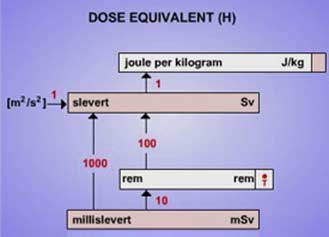
The quality factor (Q) is a factor used in radiation protection to weigh the absorbed dose with regard to its presumed biological effectiveness. Radiation with higher Q factors will cause greater damage to tissue. The rem is a term used to describe a special unit of dose equivalent. Rem is an abbreviation for roentgen equivalent in man. The SI unit is the sievert (SV); one rem is equivalent to 0.01 SV. Doses of radiation received by workers are recorded in rems, however, sieverts are being required as the industry transitions to the SI unit system.
The table below presents the Q factors for several types of radiation.
| Type of Radiation | Rad | Q Factor | Rem |
| X-Ray | 1 | 1 | 1 |
| Gamma Ray | 1 | 1 | 1 |
| Beta Particles | 1 | 1 | 1 |
| Thermal Neutrons | 1 | 5 | 5 |
| Fast Neutrons | 1 | 10 | 10 |
| Alpha Particles | 1 | 20 | 20 |
Dose Rate
The dose rate is a measure of how fast a radiation dose is being received. Knowing the dose rate, allows the dose to be calculated for a period of time. Fore example, if the dose rate is found to be 0.8rem/hour, then a person working in this field for two hours would receive a 1.6rem dose.
Biological Effects
The occurrence of particular health effects from exposure to ionizing radiation is a complicated function of numerous factors including:
- Type of radiation involved. All kinds of ionizing radiation can produce health effects. The main difference in the ability of alpha and beta particles and Gamma and X-rays to cause health effects is the amount of energy they have. Their energy determines how far they can penetrate into tissue and how much energy they are able to transmit directly or indirectly to tissues.
- Size of dose received. The higher the dose of radiation received, the higher the likelihood of health effects.
- Rate the dose is received. Tissue can receive larger dosages over a period of time. If the dosage occurs over a number of days or weeks, the results are often not as serious if a similar dose was received in a matter of minutes.
- Part of the body exposed. Extremities such as the hands or feet are able to receive a greater amount of radiation with less resulting damage than blood forming organs housed in the torso.
- The age of the individual. As a person ages, cell division slows and the body is less sensitive to the effects of ionizing radiation. Once cell division has slowed, the effects of radiation are somewhat less damaging than when cells were rapidly dividing.
- Biological differences. Some individuals are more sensitive to the effects of radiation than others. Studies have not been able to conclusively determine the differences.
The effects of ionizing radiation upon humans are often broadly classified as being either stochastic or nonstochastic. These two terms are discussed more in the next few pages.
Stochastic Effects
Stochastic effects are those that occur by chance and consist primarily of cancer and genetic effects. Stochastic effects often show up years after exposure. As the dose to an individual increases, the probability that cancer or a genetic effect will occur also increases. However, at no time, even for high doses, is it certain that cancer or genetic damage will result. Similarly, for stochastic effects, there is no threshold dose below which it is relatively certain that an adverse effect cannot occur. In addition, because stochastic effects can occur in individuals that have not been exposed to radiation above background levels, it can never be determined for certain that an occurrence of cancer or genetic damage was due to a specific exposure.
While it cannot be determined conclusively, it often possible to estimate the probability that radiation exposure will cause a stochastic effect. As mentioned previously, it is estimated that the probability of having a cancer in the US rises from 20% for non radiation workers to 21% for persons who work regularly with radiation. The probability for genetic defects is even less likely to increase for workers exposed to radiation. Studies conducted on Japanese atomic bomb survivors who were exposed to large doses of radiation found no more genetic defects than what would normally occur.
Radiation-induced hereditary effects have not been observed in human populations, yet they have been demonstrated in animals. If the germ cells that are present in the ovaries and testes and are responsible for reproduction were modified by radiation, hereditary effects could occur in the progeny of the individual. Exposure of the embryo or fetus to ionizing radiation could increase the risk of leukemia in infants and, during certain periods in early pregnancy, may lead to mental retardation and congenital malformations if the amount of radiation is sufficiently high.
Nonstochastic (Acute) Effects
Unlike stochastic effects, nonstochastic effects are characterized by a threshold dose below which they do not occur. In other words, nonstochastic effects have a clear relationship between the exposure and the effect. In addition, the magnitude of the effect is directly proportional to the size of the dose. Nonstochastic effects typically result when very large dosages of radiation are received in a short amount of time. These effects will often be evident within hours or days. Examples of nonstochastic effects include erythema (skin reddening), skin and tissue burns, cataract formation, sterility, radiation sickness and death. Each of these effects differs from the others in that both its threshold dose and the time over which the dose was received cause the effect (i.e. acute vs. chronic exposure).
There are a number of cases of radiation burns occurring to the hands or fingers. These cases occurred when a radiographer touched or came in close contact with a high intensity radiation emitter. Intensity on the surface of an 85 curie Ir-192 source capsule is approximately 1,768 R/s. Contact with the source for two seconds would expose the hand of an individual to 3,536 rems, and this does not consider any additional whole body dosage received when approaching the source.
More on Specific Nonstochastic Effects
Hemopoietic Syndrome
The hemopoietic syndrome encompasses the medical conditions that affect the blood. Hemopoietic syndrome conditions appear after a gamma dose of about 200 rads (2 Gy). This disease is characterized by depression or ablation of the bone marrow, and the physiological consequences of this damage. The onset of the disease is rather sudden, and is heralded by nausea and vomiting within several hours after the overexposure occurred. Malaise and fatigue are felt by the victim, but the degree of malaise does not seem to be correlated with the size of the dose. Loss of hair (epilation), which is almost always seen, appears between the second and third week after the exposure. Death may occur within one to two months after exposure. The chief effects to be noted, of course, are in the bone marrow and in the blood. Marrow depression is seen at 200 rads and at about 400 to 600 rads (4 to 6 Gy) complete ablation of the marrow occurs. In this case, however, spontaneous regrowth of the marrow is possible if the victim survives the physiological effects of the denuding of the marrow. An exposure of about 700 rads (7 Gy) or greater leads to irreversible ablation of the bone marrow.
Gastrointestinal Syndrome
The gastrointestinal syndrome encompasses the medical conditions that affect the stomach and the intestines. This medical condition follows a total body gamma dose of about 1000 rads (10 Gy) or greater, and is a consequence of the desquamation of the intestinal epithelium. All the signs and symptoms of hemopoietic syndrome are seen, with the addition of severe nausea, vomiting, and diarrhea which begin very soon after exposure. Death within one to two weeks after exposure is the most likely outcome.
Central Nervous System
A total body gamma dose in excess of about 2000 rads (20 Gy) damages the central nervous system, as well as all the other organ systems in the body. Unconsciousness follows within minutes after exposure and death can result in a matter of hours to several days. The rapidity of the onset of unconsciousness is directly related to the dose received. In one instance in which a 200 msec burst of mixed neutrons and gamma rays delivered a mean total body dose of about 4400 rads (44 Gy), the victim was ataxic and disoriented within 30 seconds. In 10 minutes, he was unconscious and in shock. Vigorous symptomatic treatment kept the patient alive for 34 hours after the accident.
Other Acute Effects
Several other immediate effects of acute overexposure should be noted. Because of its physical location, the skin is subject to more radiation exposure, especially in the case of low energy x-rays and beta rays, than most other tissues. An exposure of about 300 R (77 mC/kg) of low energy (in the diagnostic range) x-rays results in erythema. Higher doses may cause changes in pigmentation, loss of hair, blistering, cell death, and ulceration. Radiation dermatitis of the hands and face was a relatively common occupational disease among radiologists who practiced during the early years of the twentieth century.
The reproductive organs are particularly radiosensitive. A single dose of only 30 rads (300 mGy) to the testes results in temporary sterility among men. For women, a 300 rad (3 Gy) dose to the ovaries produces temporary sterility. Higher doses increase the period of temporary sterility. In women, temporary sterility is evidenced by a cessation of menstruation for a period of one month or more, depending on the dose. Irregularities in the menstrual cycle, which suggest functional changes in the reproductive organs, may result from local irradiation of the ovaries with doses smaller than that required for temporary sterilization.
The eyes too, are relatively radiosensitive. A local dose of several hundred rads can result in acute conjunctivitis.


